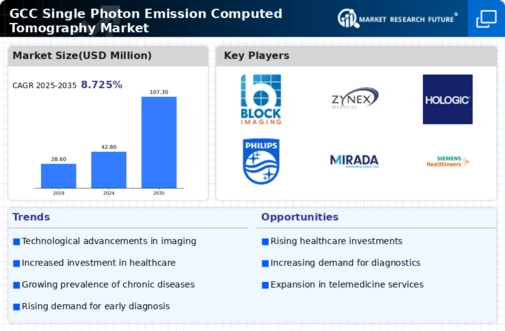The competitive dynamics within the single photon-emission-computed-tomography market are characterized by a blend of innovation, strategic partnerships, and regional expansion. Key players such as Siemens Healthineers (DE), GE Healthcare (US), and Philips Healthcare (NL) are at the forefront, each adopting distinct strategies to enhance their market presence. Siemens Healthineers (DE) emphasizes technological advancements, particularly in digital imaging solutions, which positions it as a leader in innovation. GE Healthcare (US) focuses on strategic partnerships, collaborating with local healthcare providers to tailor solutions that meet regional needs. Philips Healthcare (NL) is actively pursuing a strategy of sustainability, integrating eco-friendly practices into its product development, thereby appealing to a growing segment of environmentally conscious consumers. Collectively, these strategies contribute to a competitive environment that is increasingly focused on technological differentiation and customer-centric solutions.
The market structure appears moderately fragmented, with several key players vying for market share while also engaging in localized manufacturing and supply chain optimization. This fragmentation allows for a diverse range of offerings, catering to various healthcare needs across the region. Companies are increasingly localizing their operations to enhance responsiveness to market demands, which may lead to improved supply chain efficiencies. The collective influence of these major players shapes the market landscape, driving innovation and competitive pricing strategies.
In October 2025, Siemens Healthineers (DE) announced the launch of its latest SPECT imaging system, which incorporates advanced AI algorithms to enhance diagnostic accuracy. This strategic move not only reinforces Siemens' commitment to innovation but also positions it to capture a larger share of the market by addressing the growing demand for precise imaging solutions. The integration of AI into their systems is likely to set a new standard in the industry, potentially influencing competitors to accelerate their own technological advancements.
In September 2025, GE Healthcare (US) entered into a partnership with a leading regional hospital network to implement a comprehensive imaging solution that includes SPECT technology. This collaboration is significant as it allows GE to tailor its offerings to meet specific local healthcare challenges, thereby enhancing its competitive edge. Such partnerships may also facilitate the adoption of advanced imaging technologies in underserved areas, expanding the market reach and improving patient outcomes.
In August 2025, Philips Healthcare (NL) unveiled a new sustainability initiative aimed at reducing the carbon footprint of its SPECT systems. This initiative is indicative of a broader trend towards sustainability in healthcare technology, which is becoming increasingly important to stakeholders. By prioritizing eco-friendly practices, Philips not only differentiates itself in a crowded market but also aligns with global sustainability goals, potentially attracting a new customer base that values environmental responsibility.
As of November 2025, the competitive landscape is increasingly defined by trends such as digitalization, sustainability, and the integration of AI technologies. Strategic alliances are playing a crucial role in shaping the current market dynamics, enabling companies to leverage each other's strengths and enhance their offerings. Looking ahead, it appears that competitive differentiation will increasingly pivot from traditional price-based competition to a focus on innovation, technological advancements, and supply chain reliability. This shift may redefine how companies position themselves in the market, emphasizing the importance of delivering superior value through cutting-edge solutions.

















Leave a Comment